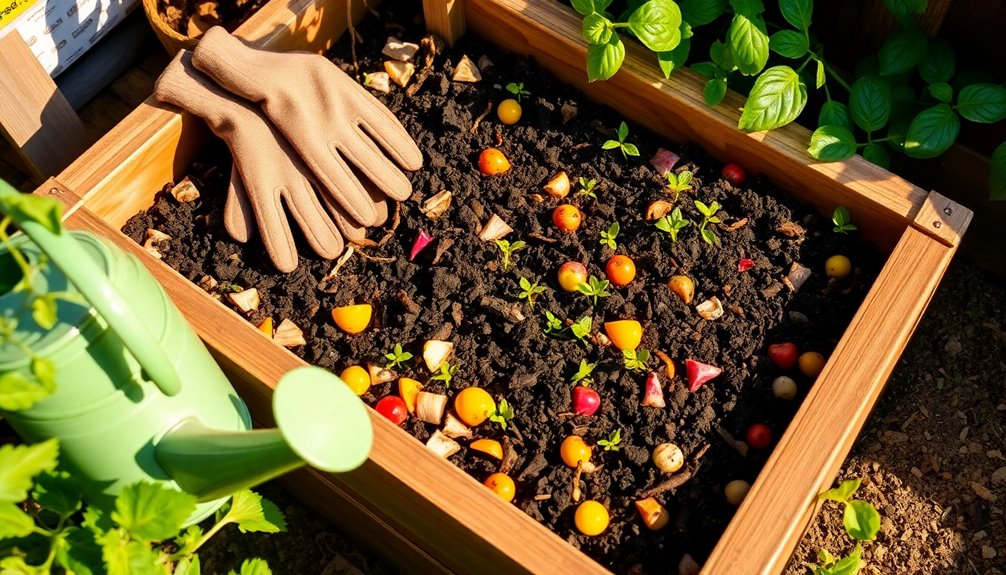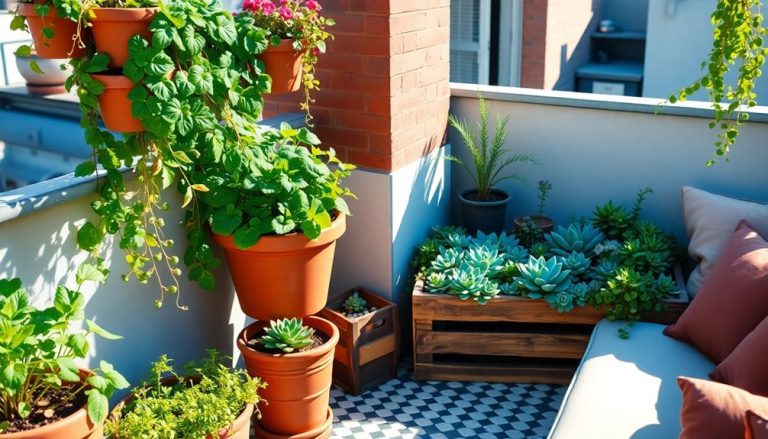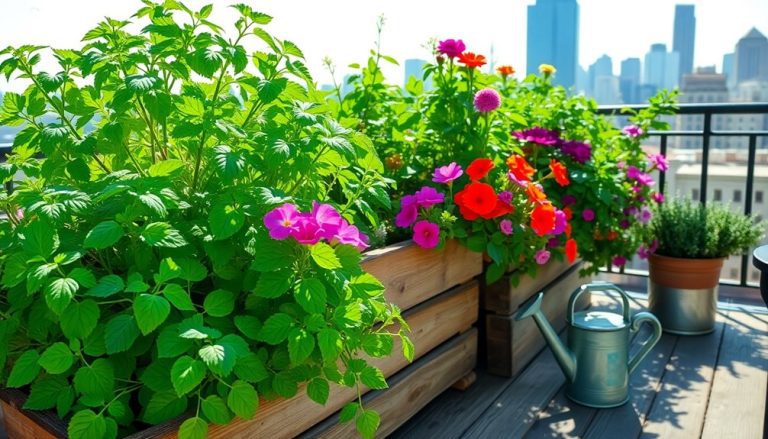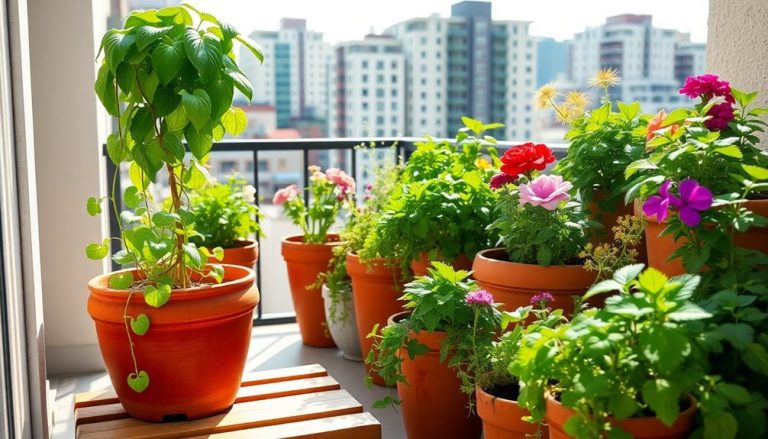You can easily compost in a tiny garden by following these essential tips. First, choose a compact bin, like a tumbler, for efficient aeration. Next, strike the right balance of green and brown materials—think fruit scraps and dry leaves. Don't forget to regularly turn your compost to keep air flowing; this keeps it healthy. Keep an eye on moisture levels; the texture should feel like a damp sponge. Lastly, harvest your compost regularly to make space for new materials and enrich your garden soil. Stick around, and you'll discover even more handy composting insights!
Key Takeaways
- Choose a compact compost bin, like a tumbler or stackable option, to maximize space in your tiny garden.
- Balance green (nitrogen-rich) and brown (carbon-rich) materials, like vegetable scraps and dry leaves, for effective composting.
- Maintain proper aeration by regularly turning the compost and adding coarse materials like straw for air pockets.
- Monitor moisture levels; aim for a damp sponge texture and adjust with dry materials if the compost is too wet.
- Harvest finished compost regularly for garden use, ensuring a dark, crumbly texture and no recognizable scraps.
Choose the Right Compost Bin
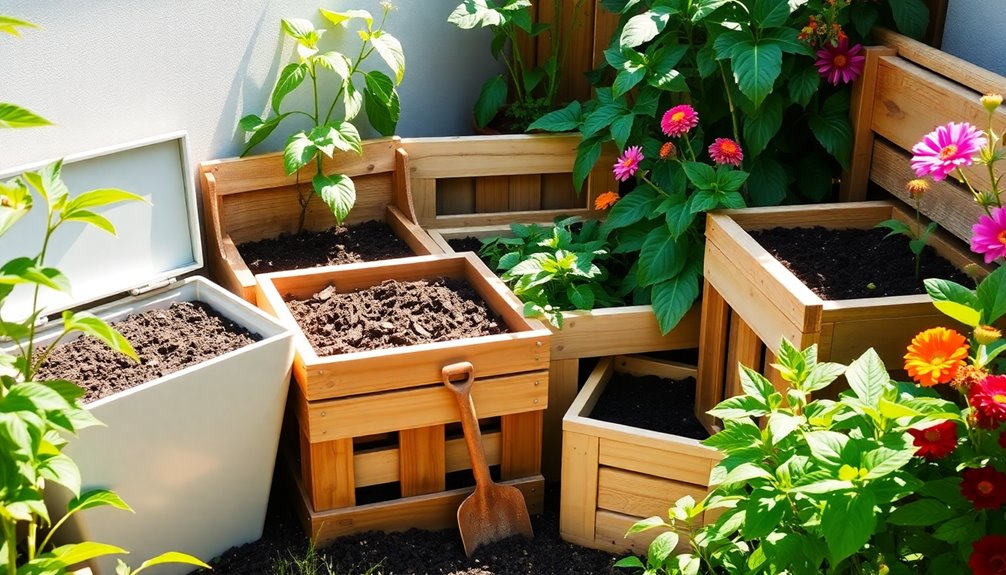
When it comes to composting in tiny gardens, choosing the right compost bin is crucial for success. You'll want a bin that fits your available space while also being efficient for breaking down organic waste.
Consider compact options like tumblers or stackable bins, which can easily slide into small corners or patios. These designs promote aeration and make it convenient for you to turn the compost, speeding up decomposition. Investing in quality compost tumblers can also enhance the efficiency of your composting process.
Think about materials too. Plastic bins are lightweight and weather-resistant, while wooden bins can blend beautifully with your garden aesthetic.
Whatever you choose, ensure it has proper ventilation and drainage to prevent odors and excess moisture.
Don't forget about accessibility! You'll want a bin that's easy to open and maintain. Look for models with hinged lids or sliding doors so you can add materials or retrieve compost without hassle.
Lastly, consider the size of your household waste. If you're generating more scraps than your tiny garden can handle, you might need a larger bin or to compost in batches. Additionally, explore the best compost bin products available to ensure you select a reliable option for your gardening needs.
Finding the right compost bin tailored to your needs will set the foundation for a successful composting experience in your small space.
Use the Right Materials
Successful composting hinges on using the right materials to create a balanced and effective mixture. To make the most of your tiny garden's composting efforts, focus on incorporating a variety of brown (carbon-rich) and green (nitrogen-rich) materials. This balance is crucial for microbial activity, which breaks down the organic matter and enriches the quality soil in your garden.
Here are four essential materials to include in your compost:
- Fruit and Vegetable Scraps: These provide vital nitrogen. Just avoid citrus peels, as they can affect acidity levels.
- Coffee Grounds: A great source of nitrogen, they also attract earthworms and enhance soil structure.
- Dry Leaves or Straw: As carbon sources, they help aerate your compost and prevent it from becoming too dense.
- Eggshells: These add calcium to your compost, promoting healthy plant growth. Just crush them before adding. Additionally, monitoring the temperature of your compost with a compost thermometer can help ensure that microbial activity remains optimal for decomposition.
Maintain Proper Aeration
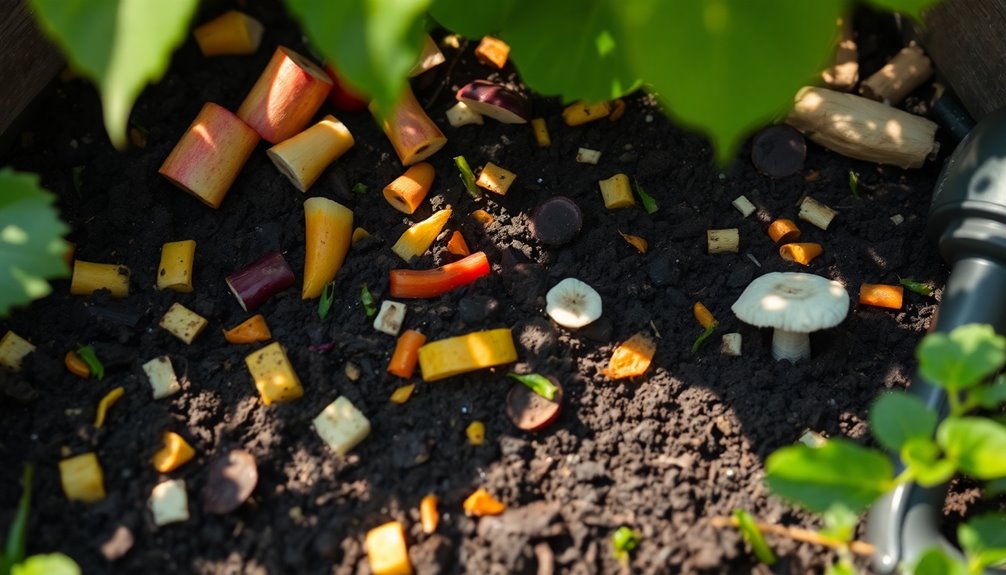
To keep your compost thriving, maintaining proper aeration is essential. Aeration allows oxygen to circulate through the pile, which is vital for the aerobic bacteria that break down organic matter. Without enough air, your compost can become compacted, leading to an unpleasant odor and slower decomposition.
One effective way to ensure aeration is to regularly turn your compost. Use a pitchfork or compost aerator to mix and fluff the materials, allowing air to penetrate deeper into the pile. Aim to turn it every few weeks, especially if you notice it's not breaking down as quickly as it should.
If your compost bin has a lid, consider leaving it slightly ajar to improve airflow. Additionally, layering your materials can help; alternate between green (nitrogen-rich) and brown (carbon-rich) materials. This not only aids aeration but also creates a balanced compost.
You can also add coarse materials like straw, small branches, or wood chips to your compost. These items create air pockets and help maintain airflow throughout the pile. Furthermore, using innovative outdoor composting solutions can enhance your composting experience by providing efficient systems that promote better aeration.
Monitor Moisture Levels
Balancing moisture levels in your compost pile is crucial for effective decomposition. Too much moisture can lead to anaerobic conditions, while too little will slow down the process. To keep your compost thriving, monitor the moisture regularly.
Here are some practical tips to help you maintain the right balance:
- Check the Texture: Grab a handful of compost and squeeze it. If it drips water, it's too wet. If it crumbles and feels dry, it needs moisture. Aim for a damp sponge consistency.
- Add Dry Materials: If your compost is too wet, mix in dry materials like shredded paper, cardboard, or dry leaves. This will help absorb excess moisture.
- Water Sparingly: On dry days, lightly spray your compost with water. Make sure not to soak it; just enough to keep it moist.
- Cover Your Pile: Use a tarp or compost cover during heavy rains to prevent excess water from saturating your pile. This keeps moisture levels stable.
Harvest Your Compost Regularly
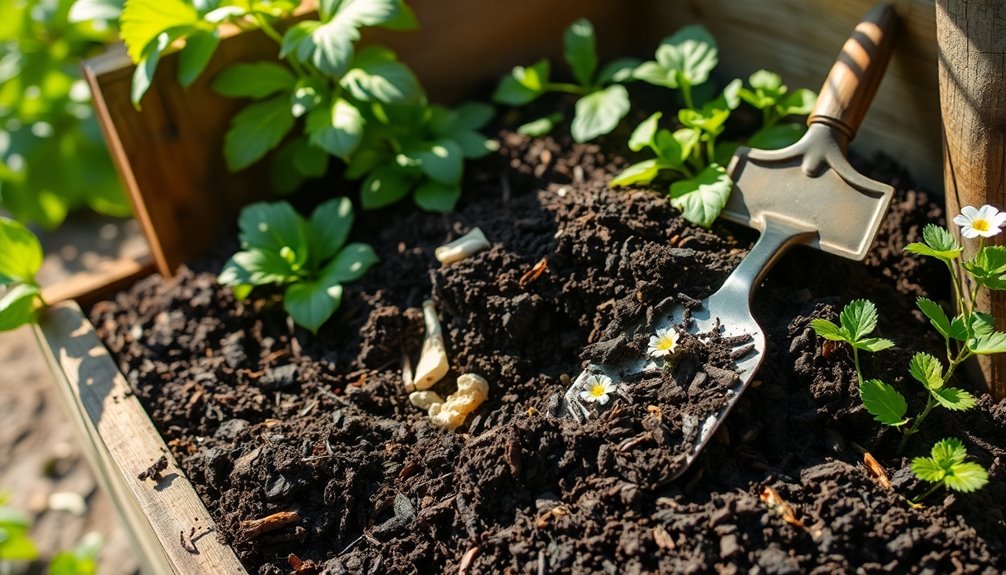
Regularly harvesting your compost is essential for keeping your tiny garden thriving. When you remove finished compost, you make space for new materials, ensuring your compost pile continues to break down efficiently. Aim to check your compost every few weeks.
To determine if your compost is ready, look for a dark, crumbly texture and an earthy smell. If you can't see any recognizable food scraps, you're on the right track. Use a shovel or pitchfork to loosen the compost, making it easier to remove.
When you harvest, take from the bottom or sides of the pile, as these areas typically break down first. This practice helps maintain airflow and encourages the remaining materials to decompose faster.
Once you've collected your compost, you can apply it directly to your garden beds or pots. Mixing it into the soil enriches your plants and boosts their growth.
Remember, composting is an ongoing process. By regularly harvesting, you're not only enhancing your garden but also keeping your compost system healthy and productive.
Frequently Asked Questions
Can I Compost Meat or Dairy in a Small Garden?
You shouldn't compost meat or dairy in a small garden. These materials can attract pests and create odors. Stick to plant-based scraps and yard waste for a healthier, more manageable composting experience in your tiny space.
How Long Does It Take to Compost in a Tiny Garden?
Composting in a tiny garden's like watching a flower bloom; it takes about two to six months. Your patience pays off as kitchen scraps transform into nutrient-rich soil, nurturing your plants and enhancing your garden's beauty.
What Pests Should I Be Aware of When Composting?
When composting, you should watch out for fruit flies, ants, and rodents. They're attracted to food scraps and can disrupt your composting process. Keep your pile covered and manage moisture to deter them effectively.
Are There Any Odors Associated With Composting in Small Spaces?
Composting's a dance, but in small spaces, odors can waltz in. If you balance greens and browns, keep it aerated, and turn regularly, you'll keep unpleasant smells at bay and enjoy fresh air instead.
How Can I Speed up the Composting Process?
To speed up composting, mix greens and browns well, maintain moisture, and regularly aerate your pile. You can also add a compost accelerator or finely chopped materials to boost decomposition. Keep it warm for best results!
Conclusion
By following these five essential composting tips, you can transform your tiny garden into a thriving ecosystem. Did you know that composting can reduce household waste by up to 30%? It's an easy way to contribute to a healthier planet while enriching your garden soil. So, get started today! With the right bin, materials, and care, you'll be well on your way to creating nutrient-rich compost that benefits both your plants and the environment.

